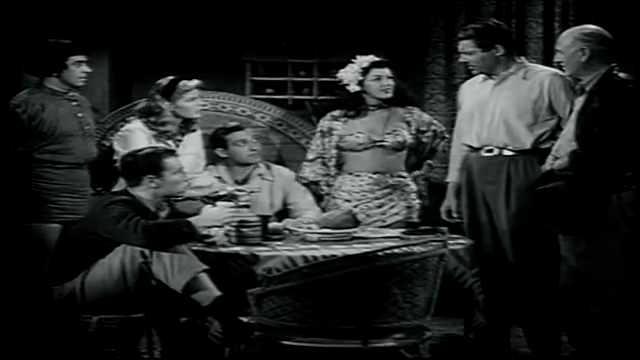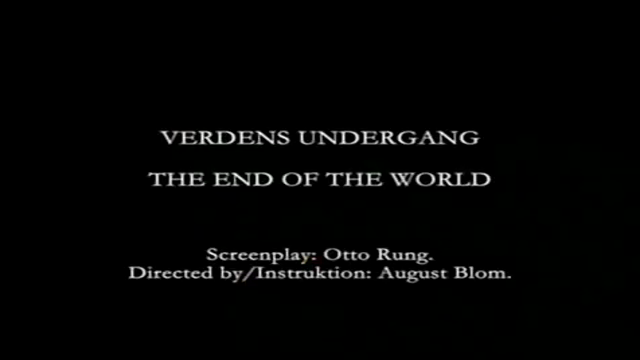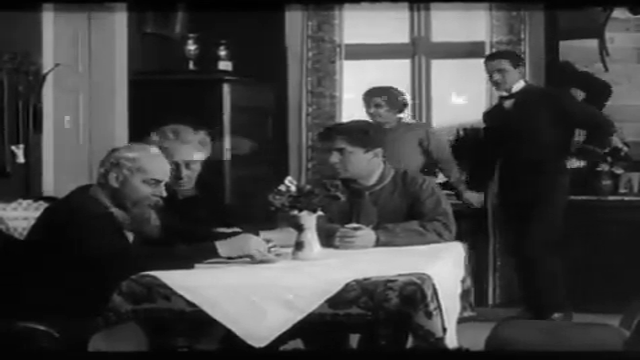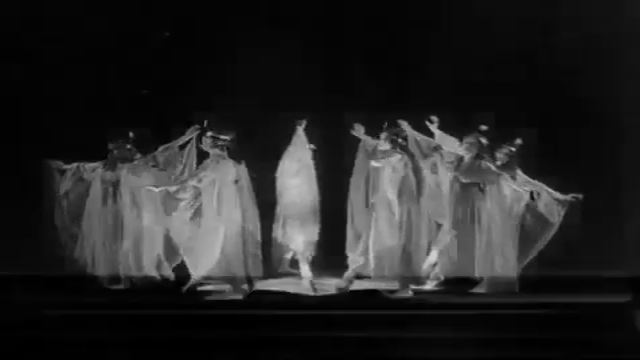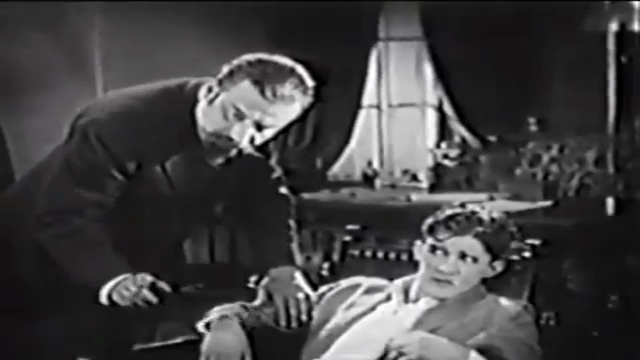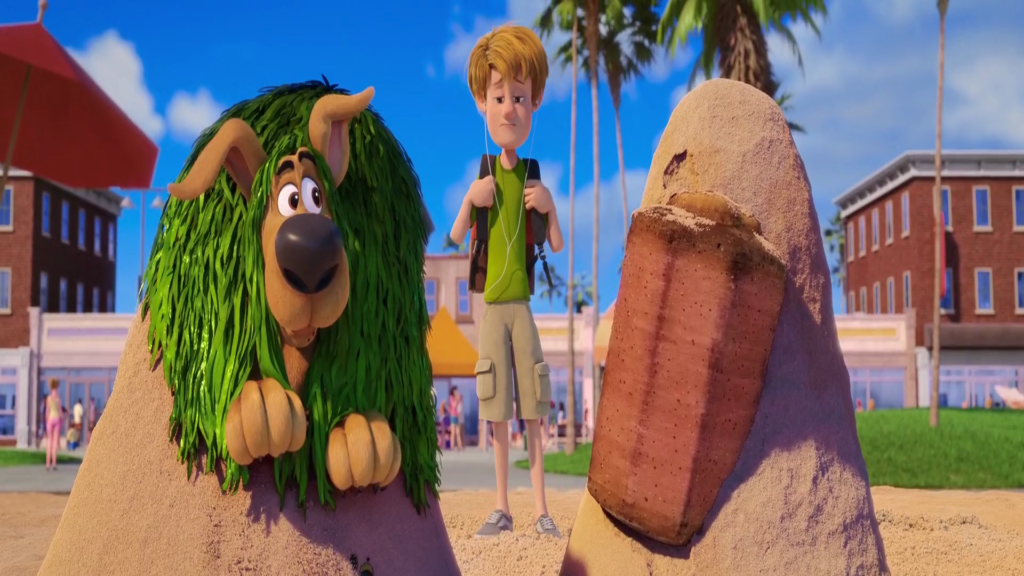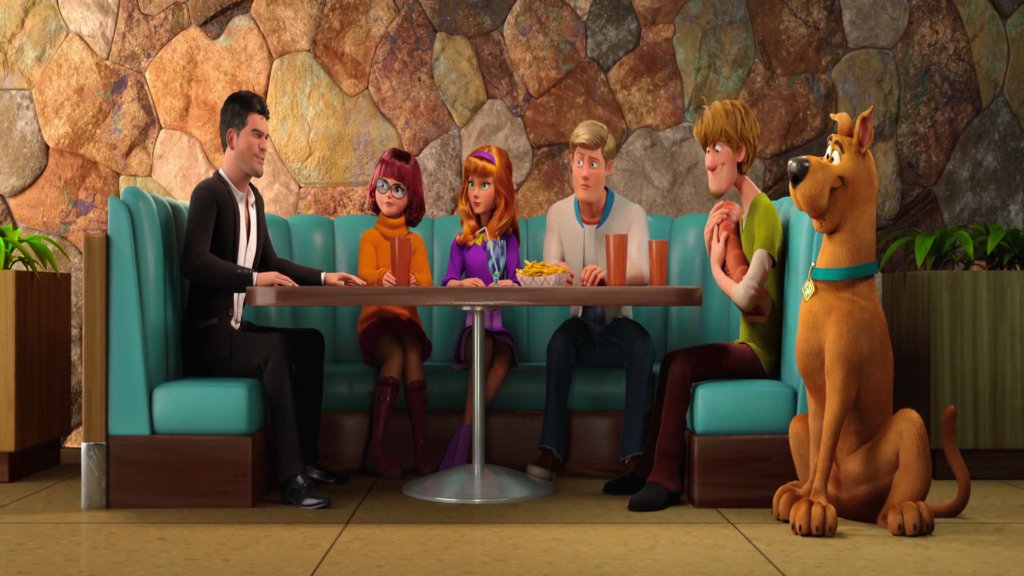-
#408 – Jack Armstrong (1947)
Jack Armstrong (1947)
Film review #408
Director: Wallace Fox
SYNOPSIS: When a valuable shipment and scientist Vic Hardy are kidnapped, young Jack Armstrong along with his friend Billie, his Sister Betty, and their Uncle Jim Fairfield, all attempt to find and rescue him. They eventually track him to an island in the Pacific, where an evil scientist has hidden Hardy away in a secret laboratory where he is building a weapon that could enslave the world. Jack and his friends must deal with the native islanders and the scientist’s henchman before the weapon is completed and the world is at their mercy…
THOUGHTS/ANALYSIS: Jack Armstrong is a 1947 movie serial based on the radio play of the same name.The serial opens up with young Jack Armstrong and his friend Billie along with his sister Bettie working on a car at the Fairfield aviation company, which Billie and Bettie’s Uncle Jim owns. Almost as soon as the serial starts, a hit and run takes place outside the Fairfield office, so Jack and Billie jump in their car and give chase. This car of theirs is a huge beast that just looks like a big steel box put over a normal car. Nevertheless, it gives the opportunity for the serial to open on an action-based note, and to entice viewers to stay and come back for the rest of the serial’s chapters. After Jack and Billie catch the driver, their car is never seen or mentioned again, which is a bit naughty opening with it and thus giving the impression you will see more of it in the next chapters.
One of Jim’s employees, Hardy, is monitoring some strange signals in the ionosphere. One of Jim’s customers named Pearce overhears this, who is working for the gang making those signals for some evil scheme, and has Hardy kidnapped so he can be forced to help with their plan. Jack and the gang track Hardy down to an island in the Pacific Ocean, which they travel to, but their plane is shot down on approach. The rest of the serial takes place on the island, where they meet the owner of a trading outpost named Grood, who is secretly the mastermind of the evil scheme to rule the world through building a weapon and deploying it in the atmosphere. The story involves Jack and the gang dealing with Grood’s henchman, as well as the native tribes that inhabit the island, and later on Pearce when he shows up on the island still pretending to be our heroes friends.
-
#407 – The End of the World (1916)
The End of the World (1916)
Film review #407
Director: August Blom
SYNOPSIS: When it is discovered that a comet is due to pass by Earth, panic and uncertainty over whether the comet will actually strike the planet. Stoll, a stock broker, sees an opportunity to make some easy money preying on people’s fears, but when the danger becomes too real, he and his wife must return to the small mining town which she fled in order to marry Stoll…
THOUGHTS/ANALYSIS: The End of the World (Verdens Undergang, also sometimes titled The Flaming Sword) is a 1916 Danish science-fiction film. The film starts off with the inhabitants of a small mining town visited by the mine’s owner, Stoll. When Stoll meets Dina, the daughter of the mine foreman at a dance, he suggests that she run away with him back to the city. Following a chastising from her Father about being a “harlot” for staying out late on her own (such as it was in 1916 I guess), Dina decides to run away with Stoll, leaving behind her Sister, Father and her friend Flint, who had hopes of marrying her himself. Fast forward a few years and we see that Stoll is a successful financier whose stock market dealings have left him very rich, and his now wife Dina has everything she could ideally want. The beginning of the film really takes some time to establish the characters and their relations. Stoll is the focal point of much of the film, and while he is marked as the villain throughout much of what is going on, he is still portrayed as having some humanity in his faithfulness and dedication to his wife. Ultimately, his manipulation of the stock market and his treatment of the mine’s workers leave him as very much an enemy to many of the other characters. Being perhaps one of the first disaster movies ever, it does the job of portraying how the end of the world impacts a number of different people from different walks of life.
When Professor Wisemann sees a new comet through his telescope coming towards Earth, the discovery generates a lot of uncertainty and panic across the world, as no one seems to know if the comet will hit the Earth or not. Stoll learns from his brother that the comet will probably hit the Earth in northwest Europe and cause significant devastation, and devises a scheme to buy a large number of stocks while there is panic, and have his friend at a newspaper print the (false headline) that the comet will not hit, leading Stoll to sell his stocks at a higher price and become even more wealthy. Even when Stoll learns of the comet’s impact, he insists the newspaper print the misleading story that it will pass by Earth so he can fulfil his scheme. Again, Stoll is made out to be the villain because profiteering over the end of the world is hardly going to go down well is it? Meanwhile, events in the mining town are moving along as Dina’s sister says farewell to her sweetheart Reymers, who has just graduated as a sailor and is leaving on board a ship.
In the third act, with the comet looming ever closer to Earth, Stoll realises the only place he can take shelter is the mine in the town where he met Dina: however, the populace are less than happy at Stoll over the way he has treated their town, and when they learn he is coming to town, Flint organises an attack on Stoll. Dina is also reluctant to return to the town, but is finally convinced. As the comet gets closer, Stoll organises a party for the end of the world, while the workers decide they are going to storm the party, setting the conflict for the final part of the film. As the comet enters the atmosphere, fragments start to rain down over the town causing mass destruction. The special effects are quite remarkable for their time, even if they’re typically just sparks flying over model buildings. Also the image of a comet overlaid into the sky of some scenes gives a feeling of impending doom. The film enjoyed a fair amount of success when it was released; in part capitalising on the fear and uncertainty surrounding Halley’s comet passing Earth a few years before, and the ongoing war in Europe which alerted people to a level of destruction they had never considered before. The film’s showing of mass destruction from meteors, houses being shaken and destroyed, and huge tidal waves gives a fair variety to the devastation and gives the feeling that nowhere is safe in these situations.
The film ends with most of the characters dying: Stoll and his wife are killed in the mine they are hiding in, Flint chases them, but the release of deadly gas kills him too. Dina’s Father passes away, and at the end we see Edith, Dina’s sister alone as she has miraculously survived. She goes up to the top of the church and rings the bell in the hope of alerting other survivors. Coincidentally, it turns out Reymers has managed to return to shore from the ship he was on, and on hearing the bell, the two are reunited to end the film on a somewhat happy note, that even through all the destruction, a sliver of hope has survived. Overall, The End of the World is a well-written spectacle that offers effects and a speculative scenario that film-goers would probably have not seen before. It’s relevance to the time is clear in regards to the amount of destruction the world was experiencing through war. The film does a good job of establishing a variety of characters and connecting them to each other, as we see how the disaster will affect people of different class and occupation, which has become one of the foundations for disaster movies. The spectacle would have engrossed movie-goers of the time, but there’s enough substance in the characters to appreciate the story underneath the spectacle too.
-
#406 – Officer 444 (1926)
Officer 444 (1926)
Film review #406
Director: Francis Ford
SYNOPSIS: When a new miracle chemical called “Haverlyite” is discovered by Professor Haverly, he intends it for the good of humanity. When he is killed by the criminal known only as “The Frog,” who wants the chemical for his own evil ends, Officer 444 of the flying squadron must stop The Frog and find Haverly’s son: the only other person who knows the secret formula for Haverlyite…
THOUGHTS/ANALYSIS: Officer 444 is a 1925 silent movie serial comprised of ten chapters. In the opening chapter, we see a building on fire, as the police and firefighters rush to get the situation under control. Officer 444, a member of the flying squadron revered by the community, heads into the burning building to rescue people trapped inside, and also to apprehend some dangerous criminals within. As is typical with these serials, the first chapter opens up with an ambitious scene involving lots of people and action in order to entice people in to coming back to the theatre for succeeding chapters, and doesn’t particularly tie in to the rest of the story. The plot itself centres around the discovery of a miracle chemical called Haverlyite, named after its discoverer Professor Haverly. The criminal known only as “The Frog” wants the formula for his own purposes, but when Haverly is killed, the secret formula dies with him…until that is, Haverly’s son appears on the scene. However he has lost his memory of the formula following his attempted abduction and his Father’s death, and so Officer 444 and The Frog do battle over young Haverly as Officer 44 tries to chase him down through the various chapters. The plot is easy enough to follow, and while nothing too special, is kept entertaining with a balance of action and investigation. The miracle formula of Haverlyite is left rather vague as to its applications: it has the power to heal people, but also to be a weapon of some form that The Frog wants to use to take over the world. The vagueness is, I think, part of the message of the film that any scientific discovery may be used for either good or evil, as evidenced by the foreword at the beginning of each chapter.
The cast of characters is fairly large, and adds some variety to proceedings: Officer 444 is the typical lead, and nurse Gloria Grey provides the typical female role, although I suppose it is a bit more involved than the glorified secretarial role most female roles have in these serials, as her nursing profession gives her purpose in scenes such as where she is working to restore young Haverly’s memories. Patrick Casey is Officer 444′s sidekick in the police force, and helps out with the more physical scenes. As you might be able to tell from the name, he fits the stereotypical Irish policeman role, but it will be a long time before cinema moved away from stereotypes. The Frog is presented as a clever criminal who disguises himself as a disfigured man. He sends a woman known only as “The Vulture” to stop 444 and interrupt his plans. While it is rare to find a second woman in a serial such as this, she does fit the role of an ambitious or clever woman that is always on the side of the villains, a role also seen in The Power God released a year earlier with the main villain’s wife. One of the more noteworthy characters is the chief of police played by August Vollmer, who was an actual police chief and one of the most influential in defining policing in the U.S. for better or worse. Dr. Blakely is a mysterious doctor whose purpose and identity provide an ongoing mystery that is only resolved in the final scenes, again providing incentive to get viewers coming back each week.
The serial does a good job of balancing the action and investigation scenes. There’s plenty of car chases filmed ambitiously, and some daring stunts such as a train switching tracks at the last second to avoid Officer 444. The fist fights aren’t as well executed, but it wasn’t until a few years later that fight choreography seemed to be more considered on film. Of particular note on the investigative side is the use of a polygraph or lie detector machine (called a “lieing machine” in the serial). This would have been a fairly recent invention and is probably the first time the device was featured on film. I wonder if Vollmer’s involvement allowed them to get their hands on one, since he would have been using them in his own police force at the time I suppose…
Overall, Officer 444 is a fairly standard serial, but at the time it garnered quite a lot of popularity from what I can tell. It’s story is easy enough to follow, but has a decent sized and varied cast who play a clear role in events. The action scenes showcase car chases and fights that are imaginatively and dramatically shot to emphasise the heroics of the heroes, and there’s enough mystery surrounding certain characters to keep viewers coming back. It’s not too noteworthy from a historical perspective, but it gives a somewhat interesting look at policing in the 1920′s if that interests you.
-
#405 – Scoob! (2020)
Scoob! (2020)
Film review #405
Director: Tony Cervone
SYNOPSIS: While Mystery inc. are looking for ways to expand their brand, Scooby-Doo and Shaggy are abducted by the super hero the Blue Falcon (or, more accurately, his son Brian). The Blue Falcon and his partners Dino-mutt and Deedee Skyes believe that Scooby-Doo is important to the evil schemes of Dick Dastardly, who is collecting the three skulls of Cerberus for some undoubtedly nefarious scheme. Meanwhile, Fred, Daphne and Velma are trying to catch up with Scooby and Shaggy in order to rescue their friends and unravel the mystery…
THOUGHTS/ANALYSIS: Scoob! is a 2020 animated film in the Scooby-Doo! franchise. Scooby-Doo is quite an odd entity: It’s a very simple show that has never been revolutionary or even had anything particularly unique. However, for some reason, it has been continuously in circulation through TV shows, reruns, and movies, for over fifty years. It’s staying power is truly unmatched for reasons we may never comprehend. It’s not to say that Scooby-Doo doesn’t deserve its status as a cultural keystone, but it’s unassuming, simple premise has rarely been altered over those fifty years, and people can still watch it and instantly recognise the characters. Maybe it’s that consistency that keeps it in circulation, and that you always get what you expect isn’t necessarily a bad thing when you’re not trying to be anything else.
So Scoob! itself starts with the origin story of Shaggy meeting Scooby-Doo. It doesn’t offer any real surprises, and I think it’s one of those origin stories that doesn’t really need to be told. Nevertheless, it sets up the theme of Scooby and Shaggy’s friendship that is the backbone of the film’s story. In the next scene we see young Shaggy and Scooby becoming friends with young Fred, Daphne and Velma, as they sole their first ‘mystery’ together. Again, the origin story doesn’t hurt, but I still wonder whether we need the origin told. The TV series A Pup named Scooby-Doo! showed the gang as kids, and I think that was enough, but at least the film doesn’t contradict that (that I know of), and obviously not everyone will be familiar with the characters, so it’s a decent way of introducing them. We then get a scene that faithfully recreates the original TV opening, with the gang being chased by all manner of monsters and ghosts. It’s a nice touch that will please fans of the franchise, and throughout the film there’s a fair amount of more minor references that fans will enjoy spotting.
Cut to the present, and the gang are sitting in a diner discussing ways to expand their business….and this where the film starts it’s slide downhill. They meet Simon Cowell (yes, voiced by him), who says that Shaggy and Scooby are holding the team back because they don’t really contribute anything. At this point, the joke about Simon Cowell judging people in a straight and harsh manner has been done and done again. I can’t really fathom why it’s in this film, other than maybe younger viewers haven’t seen it before (would they really recognise Simon Cowell though?). I get the need to have the ‘breakup’ between Scooby and Shaggy with the rest of the gang as it serves the premise of the rest of the film, but using Simon Cowell to do it just seems bizarre and distracting). There’s a lot of humour in this film that feels outdated; using jokes that have been done plenty of times before. However I think the main problem with this is that Scooby-Doo should have a timeless quality to it, which I think has formed part of its success by maintaining its universal appeal and sticking to its consistency rather than adding in current trends or trying to update the characters. Remember Scrappy-Doo? The only time they tried to change the dynamic of the franchise and how it’s been almost entirely erased from its history due to how poorly it was received and reflected on? That’s why trying to make the Scooby franchise be “relevant” is going to be detrimental to itself, and jokes about Netflix and Tinder again just aren’t funny or original. That said, there are a decent amount of funny moments that will make you laugh, but they are definitely the classic slapstick, goofy antics that you would expect from the franchise.
The film’s plot overall I think has a decent enough pacing. There’s a certain momentum in how the story develops, and it never slows down so younger viewers won’t lose interest. However, there is a lot going on, and a lot of characters that are thrown into the mix. The biggest problem in this regard is that it barely seems like a Scooby-Doo! movie at points: there’s no real mystery for the gang to unravel, and most of the story centres around The Blue Falcon stopping Dick Dastardly from unlocking the gates of the underworld. Daphne, Fred and Velma are absent from large chunks of the film, and there’s a loss of focus on the core characters at points. Dick Dastardly as the villain being concerned about his dog Muttley is a surprising mirror to Shaggy and Scooby, and I thought that in particular was interesting and could have been developed further. The film obviously isn’t trying to be a standalone Scooby-Doo! film, but to set up a “Hanna-Barbera” cinematic universe in some form. Characters like Blue Falcon, Captain Caveman and Dick Dastardly all have an appearance, but for such a big and iconic franchise as Scooby-Doo, it deserves it’s own dedicated film without worrying about an expanded universe. This also needs to another problem: that the film veers right into Marvel’s Avengers territory, and makes it a superhero film about saving the world. After ten years of the Marvel cinematic universe, I don’t think offering almost the same superhero crossover theme with less-known characters and properties is going to work. The Avengers franchise is not going to be topped anytime soon, and superhero fatigue is going to set in, rendering what is set up in Scoob! as ultimately a cheap imitation that maybe kids can like to get their fill with, but it is trying to carve a space in a genre that is saturated, and ultimately doesn’t need to be in. Don’t get me wrong: I think a Hanna-Barbera cinematic universe could work; they have a huge list of recognisable characters that could bring something to the table, but to layer all of that in a Scooby-Doo movie that already has enough content to work with ultimately dilutes the uniqueness of the characters. Going forward, I think there’s potential in maybe something in the style of the “wacky races” Hanna-Barbera cartoon (hinted at in the credits sequence) could be insanely fun in the style of a road trip with all the different characters teaming up or facing up against one another, but just another superhero cinematic universe? I don’t think it will work.
The 3D animation is something that Scooby-Doo hasn’t really ventured into, and for the most part it is fine. Scooby is well animated, and while the rest of mystery inc. aren’t quite up to par, they still move fluidly. Characters like Dick Dastardly are very expressive with their cartoon face pulling and gestures, and they really work. The problem emerges with the more ‘normal’ human characters, like Fred, Daphne, Velma, Deedee etc. in that they just can’t pull off the expressive range that the more cartoon-esque characters like Dastardly can, making them feel a little bit lifeless in comparison. Simon Cowell for example looks as ‘life-like’ as they could make him and he looks severely out of place. The voices are an area of huge controversy, as the usual voices for the Scooby-Doo characters were replaced for this film by celebrity actors apart from the voice of Frank Welker, who voices Scooby. To go back to the role of consistency in Scooby-Doo, the voice cast has been extremely consistent over fifty years, with voices only changing when an actor retires, and then their replacements are extremely close to the originals, or even chosen by them. While Frank Welker now voices Scooby, he has also voiced Fred since the very first episode for over fifty years until this film. Ditching the regular voices for actors with celebrity ‘appeal’ is a major mistake in this film. The voices of the characters are iconic, and there was no need to change them. Shaggy’s voice is a bit dreary from time to time, Daphne’s voice lacks the right tone (it’s a bit too peppy), and Velma’s is excessively dreary and makes her sound a bit too dismissive of other people’s opinions when she is conversing with them. Zac Efron voicing Fred did a better job then I was expecting, but it was a rather lifeless performance again at times, and since Welker voiced Scooby-Doo, there was no reason he could not have voiced Fred.
Overall, while Scoob! has good pacing and energy with some funny moments, it misses the mark on being a worthwhile continuation of the Scooby-Doo franchise. Combined with attempting to set up a cinematic universe with a large cast of varied characters, the film misses the simplicity and consistency of the franchise of a group of teenagers solving mysteries, chasing ghosts and some slapstick comedy from Scooby and Shaggy. The film simply tries to do too much, and neglects characters such as Fred, Daphne and Velma. The humour is hit and miss, and is best when it can surprise you, but more often than not it plays it safe and cracks a joke that has been done in plenty of films before. I think the film could have worked better if it didn’t need to simulate a ‘breakup’ between Scooby and Shaggy and the rest of Mystery inc., and focused more on the mirroring between Scooby and Shaggy and Dastardly and Muttley, framing it as more of a traditional mystery than a superhero ‘save the world’ adventure.
If you are interested in the Scooby-Doo! franchise, I say check out the Scooby-Doo! Mystery Incorporated series which is by far the best implementation of the franchise and characters by keeping the typical mystery and detective work, but also expanding on it into a larger season-wide story arc that expands the lore in exciting directions.









